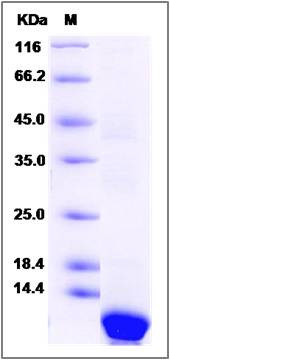Human Pepsinogen C / PGC Protein (His Tag)
PEPC,PGII
- 100ug (NPP4167) Please inquiry
| Catalog Number | P12072-H07E |
|---|---|
| Organism Species | Human |
| Host | E. coli |
| Synonyms | PEPC,PGII |
| Molecular Weight | The recombinant human PGC consists of 102 amino acids and predicts a molecular mass of 10.9 KDa. It migrates as an approximately 10 KDa band in SDS-PAGE under reducing conditions. |
| predicted N | His |
| SDS-PAGE |  |
| Purity | > 95 % as determined by SDS-PAGE |
| Protein Construction | A DNA sequence encoding the mature form of human PGC (P20142-1) (Ile153-Ile239) was expressed with a polyhistide tag at the N-terminus. |
| Bio-activity | |
| Research Area | Cancer |Signal transduction |Metabolism |Types of disease |Metabolism in Cancer |
| Formulation | Lyophilized from sterile 50mM Tris, 0.4M sucrose, 1mM EDTA, 50mM NaCl, pH 8.0 1. Normally 5 % - 8 % trehalose and mannitol are added as protectants before lyophilization. Specific concentrations are included in the hardcopy of COA. |
| Background | Pepsinogen C, also known as PGC, is an aspartic proteinase that belongs to the peptidase family A1. Pepsinogen C is synthesized in the gastric mucosa as inactive precursors, known as zymogens. Pepsinogen C contains a prosegment that serves to stabilize the inactive form and prevent entry of the substrate to the active site. At low PH conditions, Pepsinogen C undergoes conversion into active enzyme. Pepsinogen C has been found expressed in all regions of the stomach mucosa and also in the proximal duodenal mucosa. In stomach cancer tissues and cancer cell lines, the expressions of the pepsinogen genes were decreased or lost, in good accordance with their pepsinogen productions. No gross structural changes of the pepsinogen genes were observed in these cancers, but the methylation patterns of the pepsinogen genes were found to be altered in different ways in different cancers. Serum levels of Pepsinogen C are used as a biomarker for certain gastric diseases including Helicobacter pylori related gastritis. |
| Reference |
